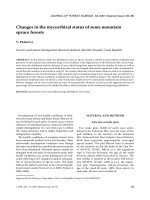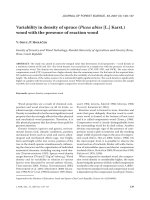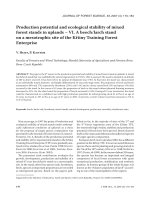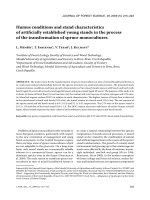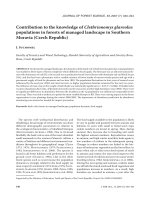Báo cáo lâm nghiệp: "Changes in the mycorrhizal status of some mountain spruce forests" potx
Bạn đang xem bản rút gọn của tài liệu. Xem và tải ngay bản đầy đủ của tài liệu tại đây (293.88 KB, 7 trang )
J. FOR. SCI., 53, 2007 (Special Issue): 82–88 82
JOURNAL OF FOREST SCIENCE, 53, 2007 (Special Issue): 82–88
Changes in the mycorrhizal status of some mountain
spruce forests
V. P
Forestry and Game Management Research Institute, Jíloviště-Strnady, Czech Republic
ABSTRACT: In the present study, the defoliation status of spruce stands is related to mycorrhizal conditions and
presence of mycorrhizal macromycetes fungi in two localities at the highest sites of the Krkonoše Mts. In the long-
term view, the defoliation and the diversity of mycorrhizal fungi have improved but the number of active as well as
nonactive mycorrhizae has decreased while their ratio has not changed. Statistically significant is the correlation be-
tween the total number of mycorrhizae and pH. e results within last years of observations as well as in comparison
to the conditions in the last decade show that mountain spruce stands growing at non-exposed sites are tolerant to a
degradation of mycorrhizal conditions resulting from the long-term air pollution impact. e studied parameters of
mycorrhizal symbiosis have not shown a clear trend; their results however indicate the stabilized mycorrhizal state.
Positive changes can be seen in the total increase of macromycetes diversity as well as in the apparent increase of
percentage of macromycetes in the studied localities, which correlates to the moderately improving defoliation.
Keywords: mycorrhizae; root; mycorrhizal fungi; defoliation; Picea abies
Development of tree health conditions is influ-
enced by many abiotic and biotic factors that are of-
ten correlated to each other. In most cases, a direct
influence of individual factors cannot be therefore
simply distinguished. It is not often easy to define
the causal direction and to define dependent and
independent variables.
e health conditions of mountain forests have
been intensively studied in the last decades. eir
unfavorable development continues even though
the major air pollution caused by the power stations
have been eliminated. Mountain spruce stands are
damaged most seriously. In the present study, their
health conditions (e.g. crown defoliation) are eval-
uated referring to the changes in quality and quan-
tity of mycorrhization of spruce roots. e study
follows the author’s previous works concerning dif-
ferent forest stands (S et al. 2003; P
2005, 2006).
MATERIAL AND METHODS
Selection of study plots
Two study plots (2,500 m
2
each) were estab-
lished in the Krkonoše Mts. near the town of Pec
pod Sněžkou, in the territory of the Krkonoše
Mts. National Park, Horní Maršov Forest District.
Both plots represent approximately even-aged
spruce stands. The plot Růžová hora is situated
on the moraine on the left bank of the Úpa Riv-
er (50°43'N, 15°44'E, 980 m a.s.l., the vegetation
type is Vaccinio-Piceetum, the age of the stand
90 years, almost 100%
Picea abies [L.] Karst.). The
plot Sněžka is situated at the locality Pod Kovár-
nou (50°44'N, 15°44'E, 1,000 m a.s.l., the vegeta-
tion type Calamagrostio villosae-Piceetum, the
age of the stand 80 years, 100% Picea abies). In
each plot, all trees were numbered.
Supported by the Ministry of Agriculture of the Czech Republic, Project No. MZe 000207021.
83 J. FOR. SCI., 53, 2007 (Special Issue): 82–88
Sampling strategy
In 2004–2006, roots and mycorrhizae were sam-
pled during the spring to early summer period
(June 5 to July 3), and the autumn period (October 2
to 9). Five samples were taken from each study plot.
Each sampling was done roughly at the same place
(not identical), approximately in the same distance
(about 1 m) from the stem of five selected trees. e
cylinder of the soil probe used for this purpose had
the inner diameter of 6 cm and the height (depth of
space sampled) of 15 cm. e probe had saw rim for
cutting roots, and inner plastic tube for stabilizing
the sample. After taking soil samples, these were
placed in refrigerator until they were processed.
Preparation of root samples
From each probe, all roots were manually pre-
pared with tweezers and preparation needles and
separated according to their diameter (P,
S 2006). en they were carefully washed
with water in order to remove as much mineral ad-
mixtures as possible; the latter complicate determi-
nation and quantification with a microscope. e
roots with diameter < 1 mm were stored in the fix-
ation solution (glutaraldehyde) to be prepared for
determination. e roots with diameter > 1 mm are
less usable for the small (6 cm) diameter probe be-
cause they are scattered irregularly in the soil and
may not be sampled appropriately. ese roots were
therefore used as additional values for measuring
the total weight of root dry matter. After analyses,
all prepared roots were dried in the kiln (24 hours
at the temperature of 105°C) and weighed with the
accuracy of 0.01 g.
Evaluation of mycorrhizal infection
and dry root matter
In this paper, the term mycorrhiza is used for
an organ that was created after the root had been
colonized with a fungus. e main factors analyzed
were the absolute numbers of active and nonactive
mycorrhizal tips (cf. P, S 2006a) and
the dry root matter within the root fraction up to
1 mm. e weight of root dry matter up to 1 mm
represents the average value of dry matter obtained
from roots separated from five soil samples. ese
thin roots are the most active part of the root sys-
tems; they adapt dynamically to changes of site con-
ditions. e numbers of active and nonactive my-
corrhizal tips were calculated from samples selected
before drying as average number of tips found in
20 main root sections (< 1 mm in diameter) of 5 cm
in length including their side branches. e level
of mycorrhizal infection was evaluated using two
parameters: density and percentage of mycorrhi-
zal tips. e active (AM) and nonactive (NM) my-
corrhizae were counted as an average value of the
number of mycorrhizal tips connected with 1 cm
of root. e percentage proportion of mycorrhizae
was calculated as a ratio of active and nonactive
mycorrhizal tips. In both experimental periods, the
roots and mycorrhizae were sampled and evaluated
according to the same standard method (P,
S 2006).
Assessment of defoliation
In the study plots, the health condition of trees
was assessed using the standard classification of
crown defoliation proposed by Rösel (R, R-
1995; F et al. 2003). It was also used
in some of our other investigations (F et al.
1995; S et al. 2001, 2003).
Assessment of fungi species occurrence
During the investigation period 2004–2006,
fruiting bodies of macromycetes were collected in
regular intervals, approximately once or twice a
month during the main fructification season (from
June to November). In all the macromycetes spe-
cies found in both plots the trophic association
was established and the ratio of mycorrhizal spe-
cies calculated. As for the spectrum of macromy-
cetes species, it is better to evaluate it as a whole
after several years. When the weather conditions
are more or less normal, at least 90% of the present
fungi species can be discovered within three years
based on the quantity of collected fruiting bodies
sufficient for assessment of the ectotrophic stability
of the forest (F, P 1995; P,
S 2006a).
Soil and climatic characteristic
e value of pH in soil suspension was used as
the major soil characteristic (the standard ČSN ISO
10390 – Soil quality – pH evaluation). e method
called pH–H
2
O is based on measuring pH of soil
samples in water (five portions of water to one por-
tion of soil); after 5 minutes of agitating and subse-
quent standing for minimally two hours (not more
than 24 hours) pH is measured potenciometrically
by means of suitable pH meter with glass combined
electrode with available extent of pH 2–9.
J. FOR. SCI., 53, 2007 (Special Issue): 82–88 84
e Czech Hydrometeorological Institute pro-
vided us with data files with air temperature (°C)
and precipitation (mm); they contained aver-
age monthly temperature and precipitation from
the station of Pec pod Sněžkou (50°55'N, 15°49'E,
816 m a.s.l.).
Evaluation methods
e obtained data can be divided into two groups.
e first one comprises average values from two
several year periods (1991–1995 and 2004–2006);
they indicate a trend but cannot be statistically well
evaluated. e second group comprises single mea-
surements that however lack the complexity of the
older investigation period.
Matrix of the obtained data was used to calculate
correlation coefficients for all variable couples. Ba-
sic calculations and graphs were created in the pro-
gramme Microsoft Excel. For further processing
of data, various modules of Statistica 6.0 (StatSoft
Inc.) were used. e correlation was tested at the
levels of significance of 0.05, 0.01 and 0.001. e
used statistical methods belong to the common
procedures described in various sources.
RESULTS
Changes in the parameters after ten years
e investigation performed on the two above-
described mountain spruce stands in 2004–2006
gave the unique opportunity to compare the results
with another investigation conducted in the same
localities ten years ago, between the years 1991 and
1995. Even if these older data are nor complete,
since some data on the soil quality are lacking,
and mycorrhizae were sampled only in the autumn
1994, they indicate some changes that occurred
during the last decade. As for the crown defoliation
assessment, a significant improvement was record-
ed after ten years. Average values of primary defo-
liation can be compared between the plots Sněžka
and Růžová hora as follows: in 1994 it was 52% in
Sněžka and 56% in Růžová hora, in 2004 the values
were 45% and 43%, respectively.
The number of macromycetes species as well as
the percentage proportion of mycorrhizal species
of fungi in the plots showed rapid positive chang-
es as follows: in Růžová hora the average number
increased after the ten-year period from 42 to
99 species of fungi, the average percentage pro
-
portion of mycorrhizal species of fungi increased
from 50% to 69%; in Sněžka the increase from
24 to 44 species was observed and from 28% to
52% of mycorrhizal fungi. The relationship be-
tween defoliation and proportion of macromyce-
tes is shown in Fig. 1. Figs. 2, 3 and 4 show average
numbers of active (AM) and nonactive (NM) my-
corrhizae, and proportion of active mycorrhizae
(%AM) in individual years. It results from the giv-
en data that in both plots relatively high densities
of active as well as nonactive mycorrhizae were
recorded in 1994; in Růžová hora the nonactive
ones were even higher. Ten years later the densi-
ties of active mycorrhizae decreased markedly, by
1.05 and 1.32 mycorrhizae to 1 cm of root length
in Sněžka and in Růžová hora, respectively. The
density of nonactive mycorrhizae decreased by
0.98 mycorrhizae to 1 cm of root length in Sněžka
and by 1.55 in Růžová hora. The percentage of ac-
tive mycorrhizae in Růžová hora in 1994 was only
by 2% higher, in Sněžka the percentage of active
mycorrhizae was identical.
When comparing the values of both investiga-
tion periods the weight of dry matter decreased;
0
10
20
30
40
50
60
70
80
1991–1995 2001–2005
(%)
Rþžováȱhora:ȱdefoliation
Sn»žka:ȱdefoliation
Rþžováȱhora:ȱfungi
Sn»žka:ȱfungi
Fig. 1. Changes in defoliation of trees and percent-
age of mycorrhizal fungi
85 J. FOR. SCI., 53, 2007 (Special Issue): 82–88
in Růžová hora the average decrease was 0.70 g, in
Sněžka 0.81 g (Fig. 5).
Changes in the parameters within the years
2004–2006
Data on mycorrhizal status of roots obtained
from spring and autumn sampling comprise the
following parameters: density of active and non-
active mycorrhizae, their ratio, the total number
of mycorrhizae, weight of dry matter of roots up
to 1 mm, numbers of mycorrhizae recorded in
a year, average defoliation, direct defoliation of
the sampled tree and percentage of mycorrhizal
species found in all the community of counted
macromycetes. Data matrix (6 sampling periods
by 26 variables) is completed with abiotic param-
eters such as altitude, pH, annual precipitation,
summer precipitation, average annual and sum-
mer temperature (from April to September). In
the matrix of these variables the basic statistical
values were calculated and the correlations were
evaluated. Except for the correlations mentioned
in Discussion any other relationships cannot be
proved. One of the reason is that the investigation
period 2004–2006 is rather short and the influence
of weather oscillation from year to year cannot be
fully eliminated.
Density of active mycorrhizae (AM, calculated as
average values of spring – autumn) varied from 0.55
(Růžová hora 2006) to 1.39 (Růžová hora, Sněžka
2005), with the average of 1.0.
0.0
0.5
1.0
1.5
2.0
2.5
Rþžová
horaȱ1994
Rþžová
horaȱ2004
Rþžová
horaȱ2005
Rþžová
horaȱ2006
Sn»žka
1994
Sn»žka
2004
Sn»žka
2005
Sn»žka
2006
AMȱdensity
spring autumn year
Fig. 2. Index of active mycorrhizae (AM) density in 1994 and 2004–2006
0.0
0.5
1.0
1.5
2.0
2.5
3.0
Rþžová
horaȱ1994
Rþžová
horaȱ2004
Rþžová
horaȱ2005
Rþžová
horaȱ2006
Sn»žka
1994
Sn»žka
2004
Sn»žka
2005
Sn»žka
2006
NMȱdensity
spring autumn year
Fig. 3. Index of nonactive mycorrhizae (NM) density in 1994 and 2004–2006
J. FOR. SCI., 53, 2007 (Special Issue): 82–88 86
Density of nonactive mycorrhizae (NM) varied
from 0.76 (Růžová hora 2005) to 1.32 (Růžová hora
2006), with the average of 1.0. eir ratio (%AM)
remained very similar reaching about 50%.
DISCUSSION
e average primary defoliation improved af-
ter ten years by 13% in Růžová hora and by 7% in
Sněžka, which corresponds to stabilization or even
improvement of tree health published in recent
articles. e positive results presented here are in
agreement with the results obtained in other stands
in the Krkonoše Mts. (F, L 2003),
even in localities that were under heavier air pol-
lution impact in the past. According to F
et al. (2003), who assessed the forest health condi-
tions in the monitoring plot Pec pod Sněžkou from
1986 to 2003, the average defoliation increased until
1997, then decreased by 3% in 1998, and stagnated
until 2003. V et al. (2007) published the results
received from permanent trial plots in the Krkonoše
Mts. showing that the first signs of spruce stands de-
struction arose after 1982, and in the first half of the
1980s the health conditions of stands gradually wors-
ened. In the period after 1988 health improvement
and decline of the stands alternated in individual
years. In the years 1996–1999, several stands within
the study plots were destroyed but others were stabi-
lized or moderately improved (1–3% per year).
e improvement of defoliation and the simulta-
neous increasing proportion of mycorrhizal species
fully agree with the hypothesis about their relation.
Data correlation within a year (however, weakened
Fig. 4. Percentage of active mycorrhizae on spruce roots in 1994 and 2004–2006
0
10
20
30
40
50
60
70
80
Rþžová
horaȱ1994
Rþžová
horaȱ2004
Rþžová
horaȱ2005
Rþžová
horaȱ2006
Sn»žka
1994
Sn»žka
2004
Sn»žka
2005
Sn»žka
2006
AMȱ(%)
spring autumn year
0.0
0.2
0.4
0.6
0.8
1.0
1.2
1.4
1.6
1.8
1994 2004 2005 2006
Rootȱdryȱmatterȱ(g)
Rþžováȱhora Sn»žka
Fig. 5. Average values of root dry matter
(root section to 1 mm in diameter) in years
1994–2006
87 J. FOR. SCI., 53, 2007 (Special Issue): 82–88
95% confidence
y ȱ=ȱ1.3611x ȱ–ȱ3.1444
R
2
ȱ=ȱ0.6908
1.0
1.2
1.4
1.6
1.8
2.0
2.2
2.4
2.6
2.8
3.0
3.4 3.5 3.6 3.7 3.8 3.9 4 4.1
pH
Densityȱofȱactiveȱandȱnonactiveȱmycorrhizae
Fig. 6. Possible correlation between density of all (active and nonactive) mycorrhizae, and pH
in consequence of variable occurrence of macro-
mycetes that are best evaluated within longer pe-
riod!) only indicates this relationship even though
the test of correlation coefficient (R
2
= 0.427) was
inconclusive (P = 0.079).
Correlation of mycorrhizae in mountain spruce
stands and summer precipitation was not proved,
contrary to very high correlation of oak mycorrhi-
zae with summer precipitation in lower altitudes
(P 2006). Generally, poor precipitations in
lower altitudes belong among the partly limiting fac-
tors whereas regular and rich precipitations in moun-
tains (Sněžka: 1,250–1,450 mm per year) are over-
supplying and sufficient soil humidity probably does
not reduce the fungal activity (mainly reduced by
droughts). No influence of summer temperature (av-
erage monthly temperature from April to September)
to any of mycorrhizal parameters was observed.
In the years 2004–2006 the values of pH in Růžová
hora varied from 3.65 do 3.97, those in Sněžka were
similar 3.49–3.77. A high negative influence of the
increase in acidity (even small differences in pH
were significant) on the number of mycorrhizae
proven in oak stands (P 2006) was statisti-
cally proven in spruce mycorrhizae only in the total
number of mycorrhizae (active and nonactive) in
the sampling in spring 2004–2006. It was the only
parameter probably positively correlated with pH
(R
2
= 0.691, P = 0.040) (Fig. 6).
Considering the obtained data, it is hard to de-
fine why the number of mycorrhizae in the plots
dropped after ten years; it concerned the rapid de-
crease of density of active as well as nonactive my-
corrhizae. However, their percentage proportion
remained unchanged after ten years. is rather
surprising decrease in the number of active and
nonactive mycorrhizae (Figs. 2 and 3) can be con-
nected with the changes in acidity as it was report-
ed by V et al. (2007). Chemical analyses of the
soil from the spruce stands in the Krkonoše Mts. in
years 1980, 1993, 1998 and 2003 gave unsteady val-
ues. In this period, pH markedly increased (from
3.59 in 1980 to 4.77 in 1998) and in the 2004–2006
investigation period it decreased to 3.78. Although
the pH values measured in the plot are not avail-
able for the oldest mycorrhizal analyses (sampling
in 1994) it can be supposed that a similar decrease
in acidity could have had a positive influence.
e total average values of active mycorrhizae
density in spruce stands are about 1.0/cm, which
is moderately higher than those found in oaks
(P 2006; 0.74/cm), however, the average of
nonactive mycorrhizae is markedly lower in spruc-
es (1.0) than in oaks (1.65). is corresponds to
the higher percentage of active mycorrhizae (50%)
found in spruces compared to oaks (30%).
CONCLUSIONS
e results of the 2004–2006 investigation period
show that some mountain spruce stands growing at
non-exposed sites are more tolerant to irreversible
degradation of mycorrhizal conditions resulting from
the long-term air pollution impact; this is confirmed
by the comparison of the results with data obtained
in the 1990s. e studied parameters of mycorrhi-
J. FOR. SCI., 53, 2007 (Special Issue): 82–88 88
zal status do not show a clear trend but indicate the
stabilized mycorrhizal state. Positive changes in the
total increase of macromycetes diversity as well as
the apparent increase of percentage of macromyce-
tes can be seen in the studied localities, which cor-
relates to the moderately improving defoliation.
Acknowledgements
We would like to thank R F and
J L for the field work, especially for
the collection and determination of macromycetes,
and to an unknown referee for valuable comments.
R ef er en ce s
FABIÁNEK P. et al., 2004. Monitoring stavu lesa v České
republice 1984–2003. Praha, Jíloviště-Strnady, MZe ČR,
VÚLHM: 431.
FELLNER R., PEŠKOVÁ V., 1995. Effects of industrial pol-
lutants on ectomycorrhizal relationships in temperate
forests. Canadian Journal of Botany, 73 (Supplementum 1):
1310–1315.
FELLNER R., SOUKUP F., PEŠKOVÁ V., KOUBA F., JAVŮREK
M., 1995. Ekologické aspekty odumírání dubů a dalších
dřevin v lesních porostech s příznaky tracheomykózního
onemocnění. [Dílčí závěrečná zpráva výzkumného projektu
č. 329-91-9106.] Jíloviště-Strnady, VÚLHM: 28.
FELLNER R., LANDA J., 2003. Mycorrhizal revival: case study
from the Giant Mts., Czech Republic. Czech Mycology, 54:
193–203.
PEŠKOVÁ V., 2005. Dynamics of oak mycorrhizas. Journal of
Forest Science, 51: 259–267.
PEŠKOVÁ V., 2006. Mykoflóra kořenových systémů lesních
dřevin. [Dizertační práce.] Praha, ČZU, FLE: 138.
PEŠKOVÁ V., SOUKUP F., 2006. Houby vázané na kořenové
systémy: metodické přístupy ke studiu. [Review.] Zprávy
lesnického výzkumu, 51: 279–286.
PEŠKOVÁ V., SOUKUP F., 2006a. Houby v lesních po
-
rostech na bývalých zemědělských půdách – metodické
přístupy k studiu jejich role. In: NEUHÖFEROVÁ P. (ed.),
Zalesňování zemědělských půd, výzva pro lesnický sektor,
Kostelec nad Černými lesy, 17. 1. 2006. Jíloviště-Strnady,
Praha, VÚLHM, VS Opočno, ČZU, KPL FLE: 127–133.
RÖSEL K., REUTHER M., 1995. Differentialdiagnostik der
Schäden an Eichen in den Donauländern. GSF – Bericht,
Neuherberg: 403.
SOUKUP F., LIŠKA J., KNÍŽEK M., PEŠKOVÁ V., 2001.
Zdravotní stav dubů v ČR a jeho ohrožení houbovými
a hmyzími škůdci. [Výroční zpráva projektu NAZV QD
0332.] Jíloviště-Strnady, VÚLHM: 23.
SOUKUP F., PEŠKOVÁ V., LIŠKA J., KNÍŽEK M., 2003.
Zdravotní stav dubů v ČR a jeho ohrožení houbovými
a hmyzími škůdci. [Závěrečná zpráva projektu NAZV QD
0332.] Jíloviště-Strnady, VÚLHM: 45.
VACEK S., MATĚJKA M., SIMON J., MALÍK V., SCHWARZ
O., PODRÁZSKÝ V., MINX T., TESAŘ V., ANDĚL P., JAN-
KOVSKÝ L., MIKESKA M., 2007. Zdravotní stav a dyna-
mika lesních ekosystémů Krkonoš pod stresem vyvolaným
znečištěním ovzduší. Kostelec nad Černými lesy, Lesnická
práce, s. r. o., Folia Forestalia Bohemica, č. 4: 216.
Změny mykorhizních poměrů v některých horských smrčinách
ABSTRAKT: Práce přináší výsledky sledování zdravotního stavu smrkových porostů na dvou studijních plochách
v nejvyšších polohách Krkonoš ve vztahu ke změnám kvality a kvantity mykorhizace jejich kořenů a prezenci myko-
rhizních hub. V dlouhodobém pohledu došlo ke zlepšení úrovně defoliace a zastoupení druhů mykorhizních hub, avšak
k poklesu počtu aktivních i neaktivních mykorhiz při zachování jejich vzájemného poměru. Statisticky významnou
korelací se ukázal vztah celkového počtu mykorhiz a pH. Změny v posledních letech – stejně jako srovnání s poměry
před deseti lety – ukazují, že horské smrkové porosty situované na poněkud chráněných místech jsou i přes stále ne
zcela uspokojivý zdravotní stav odolné vůči nevratné degradaci mykorhizních poměrů v důsledku dlouhodobé imisní
zátěže. Studované parametry mykorhizní symbiózy neprokázaly jednoznačný trend, jejich hodnoty však reprezentují
stabilizovaný mykorhizní stav. Pozitivní je celkový nárůst druhové diverzity makromycetů i výrazný trend v nárůstu
procentuálního podílu makromycetů na studovaných plochách, který odpovídá i mírně se zlepšující defoliaci.
Klíčová slova: mykorhiza; kořen; mykorhizní houby; defoliace; Picea abies
Corresponding author:
Ing. V P, Ph.D., Výzkumný ústav lesního hospodářství a myslivosti, v.v.i., Jíloviště-Strnady,
156 04 Praha 5-Zbraslav, Česká republika
tel.: + 420 257 892 299, fax: + 420 257 920 648, e-mail:


